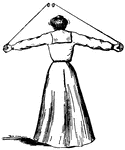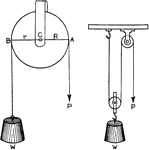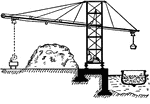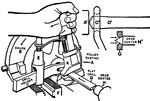
Block and Tackle
"A Block is a pulley or a system of pulleys rotating on a pintle mounted in its frame or shell with…

Block and tackle
"Combinations of pulleys are made in great variety. In the forms most commonly used, one continuous…

Block and tackle
"A combination of fixed and immovable pulleys, employed to secure what engineers call a large 'mechanical…
Compound Pulley
"If the number of ropes be increased, the weight may be increased with the same power; or the power…

Compound Pulley
"...there is a system of pulleys represented, in which the weight is sixteen times the power." -Comstock…
Compound Pulley
"Compound pulleys using one fixed and two moveable pulleys to pull a weight up by applying a downward…

Compound Pulley
"Compound pulley designed to use very little power to lift heavy weights." -Avery 1895

Differential Pulley
"In the differential pulley, an endless chain is reeved upon a solid wheel that has two grooved rims…

Dumb Waiter
An illustration of a dumb waiter which is a moveable frame in a shaft which is suspended by a rope on…
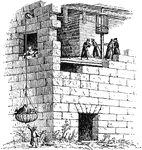
Early Elevator
This medieval elevator shows the use of two simple machines: wheel and axle on the right, and a pulley…
!["A moveable pulley is seldom used alone. It is generally combined with a fixed pulley, as shown [here]." —Quackenbos 1859](https://etc.usf.edu/clipart/36300/36351/fixmove_pull_36351_mth.gif)
Fixed and Moveable Pulley
"A moveable pulley is seldom used alone. It is generally combined with a fixed pulley, as shown [here]."…
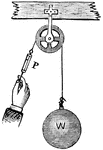
Fixed Pulley
"A pulley is a wheel having a grooved rim for carrying a rope or other line, and tuning on an axis carried…

Fixed Pulley
"A fixed pulley is one whose block is not movable. In this case, if the weight W be lifted by pulling…
!["[This illustration] represents a fixed pulley. The block is attached to a projecting beam. P is the power, and W the weight. For every inch that P descends, W ascends the same distance." —Quackenbos 1859](https://etc.usf.edu/clipart/36300/36349/fixed_pulley_36349_mth.gif)
Fixed Pulley
"[This illustration] represents a fixed pulley. The block is attached to a projecting beam. P is the…
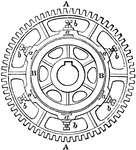
Friction Wheel
"In machinery, a form of slip-coupling applied in cases where the variations of load are sudden and…
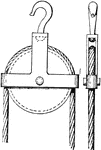
Gin-Block
"GIN-BLOCK. A simple form of tackle-block with a single wheel, over which a rope runs. It has a hook…
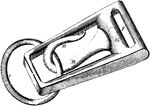
Safety Purpose Lifting Hook
A lifting hook is a device used for grabbing and lifting loads by means of a device such as a hoist…

Lapidary's Mill
"Part of Lapidary's Mill. A, upper summer (cut through); B, lower summer (cut through); C, spindle;…

First Kind of Lever
"In straight levers of the first kind, the fulcrum is between the power and the resistance, as in fig…

Simple Machine
A fixed pulley. It is called such because the block is attached to the ceiling and cannot move.

Movable pulley
"A pulley is a wheel having a grooved rim for carrying a rope or other line, and turning on an axis…

Movable Pulley
"A movable pulley is one whos block is movable. One end of the cord is fastened to the beam, and the…
!["[This illustration] represents a moveable pulley. A is the wheel. One end of the rope is fastened to a support at D, while the power is applied to the other at P." —Quackenbos 1859](https://etc.usf.edu/clipart/36300/36350/move_pulley_36350_mth.gif)
Moveable Pulley
"[This illustration] represents a moveable pulley. A is the wheel. One end of the rope is fastened to…

Movable Pulleys
"System of moveable pulleys. Each pulley has a separate rope attached to a fixed support at one end."…
Multiple Pulleys
"When a high degree of force is required, several moveable pulleys may be combined, as represented [here].…
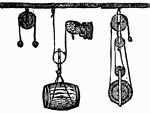
Pulley
A wheel for transmitting power from, or imparting it to the different parts of machinery, or for changing…

Pulley
"A pulley is a grooved wheel, around which a rope is passed, and is either fixed or moveable." —…
Pulley
"The pulley is a lever with equal arms of the first or second class, but, when it moves. the attachments…

Pulley
One of the six simple machines or mechanical powers. It consists of a grooved wheel mounted in a block,…
!["[The pulley] consists of a wheel with a grooved circumference, over which a rope passes, and an axis or pin, round which the wheel may be made to turn. A represents the block, B the axis, C the wheel." —Quackenbos 1859](https://etc.usf.edu/clipart/36300/36348/pulley_36348_mth.gif)
Pulley
"[The pulley] consists of a wheel with a grooved circumference, over which a rope passes, and an axis…

Pulley
A pulley (also called a block) is a mechanism composed of a wheel (called a sheave) with a groove between…
Pulley
A pulley (also called a block) is a mechanism composed of a wheel (called a sheave) with a groove between…

Pulley
A pulley, also called a sheave or a drum, is a mechanism composed of a wheel on an axle or shaft that…

Pulley Blocks
An illustration of a block pulley. A pulley (also called a block) is a mechanism composed of a wheel…
Pulley Blocks
An illustration of a block pulley. A pulley (also called a block) is a mechanism composed of a wheel…
Pulley Blocks
An illustration of a block pulley. A pulley (also called a block) is a mechanism composed of a wheel…
!["A horse without machinery can not lift a weight; but he does it readily with the aid of the simple apparatus shown [here].." —Quackenbos 1859](https://etc.usf.edu/clipart/36300/36331/pulley_sys_36331_mth.gif)
Pulley System
"A horse without machinery can not lift a weight; but he does it readily with the aid of the simple…
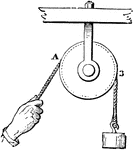
Pulley System
A pulley, when fixed in such a way that it can only turn about a fixed axis, confers no mechanical advantage.

Pulley System
This pulley arrangement gives a mechanical advantage of 2; for the lower, movable pulley may be regarded…
Pulley System
This figure has six pulleys and one cord passes round them all. Each pulley is stretched with the same…

Pulley System
This arrangement have three movable pulleys, each hanging by a separate cord. The mechanical advantage…

Compound Pulley
"Many wheels may be combined together, and in many ways, to form compound pulleys. Whenever there is…
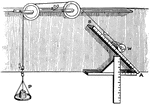
Incline Plane Pulley
An illustration of an inclined plane pulley. "Let the weight w be started to move p the plane, and let…
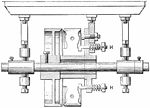
Loose Driving Pulley
"The belt is thrown on to set the machine in motion, the loose pulley is pressed aside by the spiral…

Sash Pulley
A pulley is a mechanism of a wheel on an axle or shaft that may have a groove between two flanges around…

Pulleys
"Pulleys designed to allow the weight to be pulled up while the power is applied downwards." -Avery…

Pulleys - Smeaton's Blocks
"A system of pulleys in two blocks, so arranged that the parts of continuous rope are approximately…
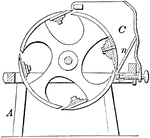
Grooved Pulleys
These pulleys are grooved such as to guide the inner belt, in this system there is less of a chance…

Detail of Wheeler and Wilson Sewing Machine
A detail of the Wheeler and Wilson Sewing Machine. "s, thread-leader; t, face-plate covering...; v,…

Shafting
"In machinery, the system of shafts which connects machinery with the prime mover, and through which…
Shoe Block
"Nautically, a block with two sheaves, whose axes are at right angles to each other, used for the buntlines…




